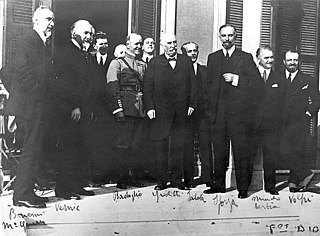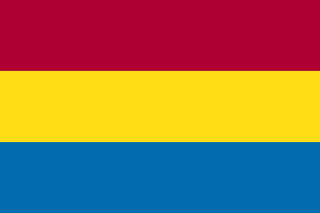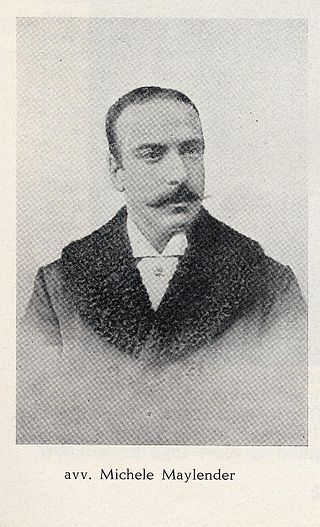
Rijeka, Italian: Fiume, is the principal seaport and the third-largest city in Croatia. It is located in Primorje-Gorski Kotar County on Kvarner Bay, an inlet of the Adriatic Sea and in 2021 had a population of 108,622 inhabitants. Historically, because of its strategic position and its excellent deep-water port, the city was fiercely contested, especially between the Holy Roman Empire, Italy and Croatia, changing rulers and demographics many times over centuries. According to the 2011 census data, the majority of its citizens are Croats, along with small numbers of Serbs, Bosniaks and Italians.
The Treaty of Rome was agreed on 27 January 1924, when Italy and the Kingdom of Serbs, Croats and Slovenes agreed that Fiume would be annexed to Italy as the Province of Fiume, and the town of Sušak would be part of the Kingdom of Serbs, Croats and Slovenes.

The Treaty of Rapallo was an agreement between the Kingdom of Italy and the Kingdom of Serbs, Croats and Slovenes in the aftermath of the First World War. It was intended to settle the Adriatic question, which referred to Italian claims over territories promised to the country in return for its entry into the war against Austria-Hungary, claims that were made on the basis of the 1915 Treaty of London. The wartime pact promised Italy large areas of the eastern Adriatic. The treaty, signed on 12 November 1920 in Rapallo, Italy, generally redeemed the promises of territorial gains in the former Austrian Littoral by awarding Italy territories generally corresponding to the peninsula of Istria and the former Princely County of Gorizia and Gradisca, with the addition of the Snežnik Plateau, in addition to what was promised by the London treaty. The articles regarding Dalmatia were largely ignored. Instead, in Dalmatia, Italy received the city of Zadar and several islands. Other provisions of the treaty contained safeguards for the rights of Italian nationals remaining in the Kingdom of Serbs, Croats and Slovenes, and provisions for commissions to demarcate the new border, and facilitate economic and educational cooperation. The treaty also established the Free State of Fiume, the city-state consisting of the former Austro-Hungarian Corpus separatum that consisted of Rijeka and a strip of coast giving the new state a land border with Italy at Istria.

Riccardo Zanella was a Fiuman politician who was the only elected president of the short-lived Free State of Fiume.

The Free State of Fiume was an independent free state that existed between 1920 and 1924. Its territory of 28 km2 (11 sq mi) comprised the city of Fiume and rural areas to its north, with a corridor to its west connecting it to the Kingdom of Italy.

The Italian Regency of Carnaro was a self-proclaimed state in the city of Fiume led by Gabriele d'Annunzio between 1919 and 1920.
The Autonomist Party was an Italian-Dalmatianist political party in the Dalmatian political scene, that existed for around 70 years of the 19th century and until World War I. Its goal was to maintain the autonomy of the Kingdom of Dalmatia within the Austro-Hungarian Empire, as opposed to the unification with the Kingdom of Croatia-Slavonia. The Autonomist Party has been accused of secretly having been a pro-Italian movement due to their defense of the rights of ethnic Italians in Dalmatia. The Autonomist Party did not claim to be an Italian movement, and indicated that it sympathized with a sense of heterogeneity amongst Dalmatians in opposition to ethnic nationalism. In the 1861 elections, the Autonomists won twenty-seven seats in Dalmatia, while Dalmatia's Croatian nationalist movement, the National Party, won only fourteen seats. This number rapidly decreased: already in 1870 autonomists lost their majority in the Diet, while in 1908 they won just 6 out of 43 seats.

Michele Maylender was a politician from Austria-Hungary who was the founder of the Autonomist Association, known also as the Autonomist Party in Fiume.

Giovanni de Ciotta was the first-born son of Lorenzo de Ciotta and Luisa de Adamich, daughter of the foremost Fiuman merchant and father of modernisation in Fiume, Andrea Lodovico de Adamich. The family de Ciotta originated from Livorno, where Giovanni served the Austrian army as an engineer. As an officer of the Austrian engineer corps, he fought in Italy in the 1848-49 campaigns and remained in the army until 1859. He arrived in Fiume in 1859 from Livorno, after having resigned from the Austrian army, reputedly for political reasons. In Fiume, initially, he lived as a landlord and commercial agent for his brother Lorenzo, who ran a trading company in Livorno, but Giovanni de Ciotta soon turned to engineering. Nevertheless, his personal life remains a mystery.
Luigi Ossoinack. Born in Fiume, studied in Ljubljana, Graz and Vienna, where he graduated at the commercial academy. He practised trade in Trieste, Odessa, London and North America.
The Communist Party of Fiume was instituted in November 1921, after the proclamation of the Free State of Fiume created by the Treaty of Rapallo. The Communist Party of Fiume was the smallest Communist Party in the world at the time. It was founded following the principles of the Third International, according to which each sovereign State had to have its own Communist Party organization.
The Autonomist Association was a political party in Fiume, that existed continuously from 1896 to 1914. Its goal was to maintain the autonomy of the corpus separatum of Fiume within the Hungarian Kingdom.
Rijeka, formerly known as Fiume, is a city located in the northern tip of the Kvarner Gulf in the northern Adriatic. It is currently the third-largest city in Croatia. It was part of the Roman province of Dalmatia, and later of the Kingdom of Croatia. It grew during the 12th to 14th centuries as a seaport within the Holy Roman Empire, trading with Italian cities. Under the rule of the House of Habsburg from 1466, it was made a free city; and, although part of the Duchy of Carniola, it developed local self-government.
The Italian National Council of Fiume was a political body that governed the city of Fiume between 1918 and 1924.
Mario Blasich was an Italian politician and physician, and an important member of the Autonomist Party of Fiume, during the short-lived autonomy of the Free State of Fiume.
The Bloody Christmas of 1920 was a series of clashes in Fiume, which led to the conclusion of the Fiume campaign that was carried out by the Italian poet and adventurer Gabriele D'Annunzio in 1920.
In the aftermath of the First World War, the Adriatic question or Adriatic problem concerned the fate of the territories along the eastern coast of the Adriatic Sea that formerly belonged to the Austro-Hungarian Empire. The roots of the dispute lay in the secret Treaty of London, signed during the war, and in growing nationalism, especially Italian irredentism and Yugoslavism, which led ultimately to the creation of Yugoslavia. The question was a major barrier to agreement at the Paris Peace Conference, but was partially resolved by the Treaty of Rapallo between Italy and Yugoslavia on 12 November 1920.
Events from the year 1919 in Italy.
In the aftermath of the First World War, the Fiume Question, part of the larger Adriatic Question or Adriatic Problem, concerned the fate of the territory that was part of the Corpus Separatum of Fiume, the Royal Free City and one of the only two free ports of Austria-Hungary.
The Liburnian Autonomous Movement or the Liburnian Federalist Movement was a political group founded in Rijeka in the summer of 1943, disbanded in the last months of the Second World War. Its most prominent members were killed during the Fiume Autonomists purge.






